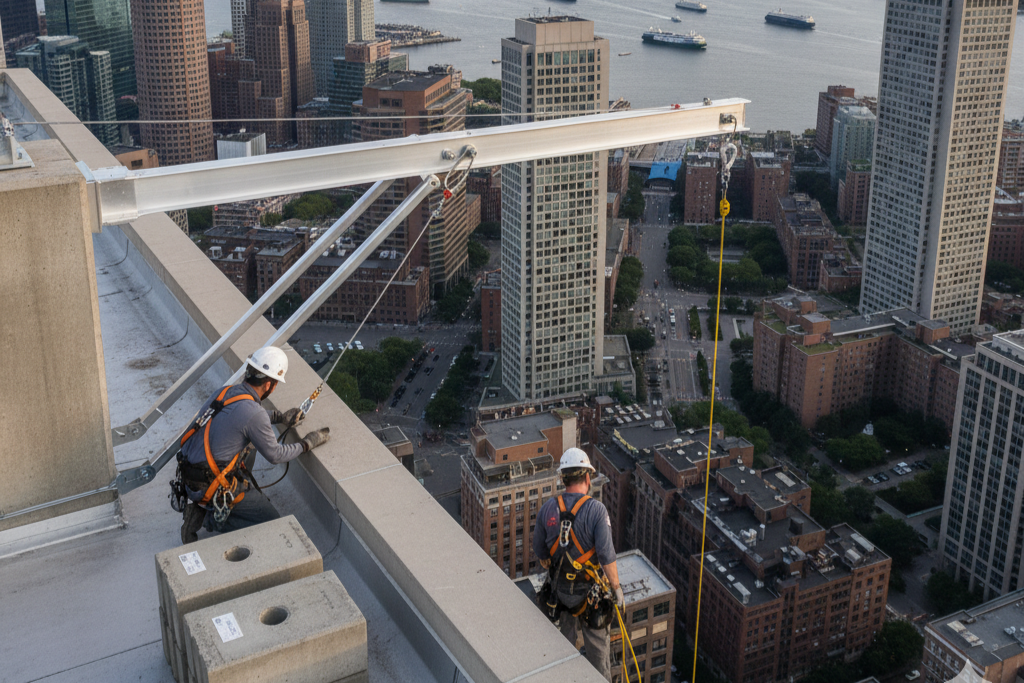
When crews need a stable platform over the edge, outriggers provide the secure reach that keeps people and projects moving. On dense urban sites in Boston, MA, these beams let teams stage swing stages or controlled descent without shutting down sidewalks or occupying street lanes for long stretches.
What an outrigger actually does
An outrigger is a structural beam set on the roof that projects over the parapet to support a load below. It shifts forces back into the roof through counterweights or direct structural attachments so the platform hangs plumb. That over-the-edge reach is why outriggers are a go-to for window cleaning and facade repairs across Boston, MA.
Why use outriggers instead of ground equipment
Street permits, traffic, and tight alleys make ground booms impractical on many blocks in Boston, MA. Outriggers move the work zone to the roof, reducing ground disruption and allowing repeatable, planned drops that align with your building’s access routine.
The anatomy in plain language
Most setups include the beam, a fulcrum at the parapet, inboard length on the roof, outboard length beyond the edge, approved counterweights or anchors, and rated tie-backs. Hardware for sheaves, lifelines, and secondary attachments completes the system. Clear labeling helps visiting vendors move faster on multi-tenant properties in Boston, MA.
Counterweights: where stability starts
Counterweights balance the tipping moment created by the suspended load. They must be solid, non-flowable, and secured so nothing shifts during use. Crews should verify counts, placement, and pinning before the first lift, a step that is scrutinized during inspections in Boston, MA. Outriggers must be engineered to support at least twice the intended load, including platform, personnel, and dynamic forces.
Tie-backs and direct connections
Even when counterweighted, beams need restraint to prevent movement. Tie-backs connect the beam to rated roof anchors in straight lines free of sharp edges or obstructions. OSHA requires tie-backs rated for at least 5,000 lbs or part of a certified engineered system. On some roofs in Boston, MA, engineers specify direct structural connections rather than counterweights, especially when space is limited or parapets are delicate.
Placement and geometry that actually work
Good placement clears cornices, signage, and recessed bays while keeping the inboard run accessible for inspection. A common rule is maintaining a longer inboard than outboard length, but the exact ratio is engineered for each site. That detail matters in older buildings in Boston, MA, where parapet conditions vary widely.
A simple setup checklist that crews will use
Walk the edge, confirm drop lines, and measure parapet height. Verify the beam rating and outreach, then stage counterweights and tie-backs exactly as shown on drawings. Inspect pins, sheaves, and rope paths, and post a quick diagram at the hatch. This repeatable rhythm helps mixed crews stay consistent on busy schedules in Boston, MA.
Wind, weather, and coastal realities
Gusts off the harbor can load a platform from the side, so teams need clear wind thresholds and a plan for sudden changes. Frozen parapet caps and ice on roof membranes also affect the footing. Seasonal briefings before winter reduce surprises for contractors rotating through Boston, MA.
Training, labels, and logs
No beam is safer than the people using it. Keep labels legible, store a current equipment log on site, and require a short tailgate before each setup. Posting a laminated one-page quick guide near access points helps new technicians who may be in their first week in Boston, MA. Include a visual aid showing outrigger base locations, tie-back paths, and drop zones to reduce confusion and improve safety.
Inspection rhythm and rescue planning
ANSI recommends annual inspections by a qualified person, plus visual checks before each use. Load testing is typically required every five years or after major modifications. Suspended access systems also require a written rescue plan—especially important for high-rises in Boston, MA, where alleyways and setbacks complicate retrieval.
Avoid these common mistakes
Skipping tie-backs, mixing counterweight brands or weights, and running ropes across sharp edges are preventable errors. Another red flag is using makeshift anchors that are not rated for the task. A quick pre-use review closes these gaps and is standard practice on well-managed sites in Boston, MA.
Budget and lifecycle
Outriggers pay off when you have recurring facade work. Durable beams, properly stored, can serve for years, while standardized components simplify training and inspections across a portfolio. Owners in Boston, MA often see fewer schedule delays and more predictable maintenance once a roof-based access plan is in place.
Next step
Want to translate roof-side stability into safe, efficient platform operation? Read next: Swing Stages: Safety Tips and Best Practices for platform setup, load planning, and daily checks that keep jobs on track.
Get a practical plan for your building
If you’re weighing counterweights, tie-backs, or direct connections, we can help with drawings, testing, and a clear playbook. Explore Fall protection to connect with our team for a site walk and a right-sized solution that fits your operations in Boston, MA.


